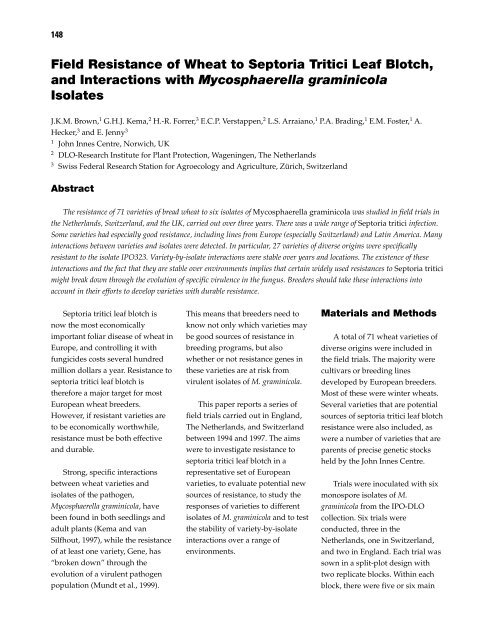Septoria and Stagonospora Diseases of Cereals - CIMMYT ...
Septoria and Stagonospora Diseases of Cereals - CIMMYT ...
Septoria and Stagonospora Diseases of Cereals - CIMMYT ...
You also want an ePaper? Increase the reach of your titles
YUMPU automatically turns print PDFs into web optimized ePapers that Google loves.
148<br />
Field Resistance <strong>of</strong> Wheat to <strong>Septoria</strong> Tritici Leaf Blotch,<br />
<strong>and</strong> Interactions with Mycosphaerella graminicola<br />
Isolates<br />
J.K.M. Brown, 1 G.H.J. Kema, 2 H.-R. Forrer, 3 E.C.P. Verstappen, 2 L.S. Arraiano, 1 P.A. Brading, 1 E.M. Foster, 1 A.<br />
Hecker, 3 <strong>and</strong> E. Jenny3 1 John Innes Centre, Norwich, UK<br />
2 DLO-Research Institute for Plant Protection, Wageningen, The Netherl<strong>and</strong>s<br />
3 Swiss Federal Research Station for Agroecology <strong>and</strong> Agriculture, Zürich, Switzerl<strong>and</strong><br />
Abstract<br />
The resistance <strong>of</strong> 71 varieties <strong>of</strong> bread wheat to six isolates <strong>of</strong> Mycosphaerella graminicola was studied in field trials in<br />
the Netherl<strong>and</strong>s, Switzerl<strong>and</strong>, <strong>and</strong> the UK, carried out over three years. There was a wide range <strong>of</strong> <strong>Septoria</strong> tritici infection.<br />
Some varieties had especially good resistance, including lines from Europe (especially Switzerl<strong>and</strong>) <strong>and</strong> Latin America. Many<br />
interactions between varieties <strong>and</strong> isolates were detected. In particular, 27 varieties <strong>of</strong> diverse origins were specifically<br />
resistant to the isolate IPO323. Variety-by-isolate interactions were stable over years <strong>and</strong> locations. The existence <strong>of</strong> these<br />
interactions <strong>and</strong> the fact that they are stable over environments implies that certain widely used resistances to <strong>Septoria</strong> tritici<br />
might break down through the evolution <strong>of</strong> specific virulence in the fungus. Breeders should take these interactions into<br />
account in their efforts to develop varieties with durable resistance.<br />
<strong>Septoria</strong> tritici leaf blotch is<br />
now the most economically<br />
important foliar disease <strong>of</strong> wheat in<br />
Europe, <strong>and</strong> controlling it with<br />
fungicides costs several hundred<br />
million dollars a year. Resistance to<br />
septoria tritici leaf blotch is<br />
therefore a major target for most<br />
European wheat breeders.<br />
However, if resistant varieties are<br />
to be economically worthwhile,<br />
resistance must be both effective<br />
<strong>and</strong> durable.<br />
Strong, specific interactions<br />
between wheat varieties <strong>and</strong><br />
isolates <strong>of</strong> the pathogen,<br />
Mycosphaerella graminicola, have<br />
been found in both seedlings <strong>and</strong><br />
adult plants (Kema <strong>and</strong> van<br />
Silfhout, 1997), while the resistance<br />
<strong>of</strong> at least one variety, Gene, has<br />
“broken down” through the<br />
evolution <strong>of</strong> a virulent pathogen<br />
population (Mundt et al., 1999).<br />
This means that breeders need to<br />
know not only which varieties may<br />
be good sources <strong>of</strong> resistance in<br />
breeding programs, but also<br />
whether or not resistance genes in<br />
these varieties are at risk from<br />
virulent isolates <strong>of</strong> M. graminicola.<br />
This paper reports a series <strong>of</strong><br />
field trials carried out in Engl<strong>and</strong>,<br />
The Netherl<strong>and</strong>s, <strong>and</strong> Switzerl<strong>and</strong><br />
between 1994 <strong>and</strong> 1997. The aims<br />
were to investigate resistance to<br />
septoria tritici leaf blotch in a<br />
representative set <strong>of</strong> European<br />
varieties, to evaluate potential new<br />
sources <strong>of</strong> resistance, to study the<br />
responses <strong>of</strong> varieties to different<br />
isolates <strong>of</strong> M. graminicola <strong>and</strong> to test<br />
the stability <strong>of</strong> variety-by-isolate<br />
interactions over a range <strong>of</strong><br />
environments.<br />
Materials <strong>and</strong> Methods<br />
A total <strong>of</strong> 71 wheat varieties <strong>of</strong><br />
diverse origins were included in<br />
the field trials. The majority were<br />
cultivars or breeding lines<br />
developed by European breeders.<br />
Most <strong>of</strong> these were winter wheats.<br />
Several varieties that are potential<br />
sources <strong>of</strong> septoria tritici leaf blotch<br />
resistance were also included, as<br />
were a number <strong>of</strong> varieties that are<br />
parents <strong>of</strong> precise genetic stocks<br />
held by the John Innes Centre.<br />
Trials were inoculated with six<br />
monospore isolates <strong>of</strong> M.<br />
graminicola from the IPO-DLO<br />
collection. Six trials were<br />
conducted, three in the<br />
Netherl<strong>and</strong>s, one in Switzerl<strong>and</strong>,<br />
<strong>and</strong> two in Engl<strong>and</strong>. Each trial was<br />
sown in a split-plot design with<br />
two replicate blocks. Within each<br />
block, there were five or six main









